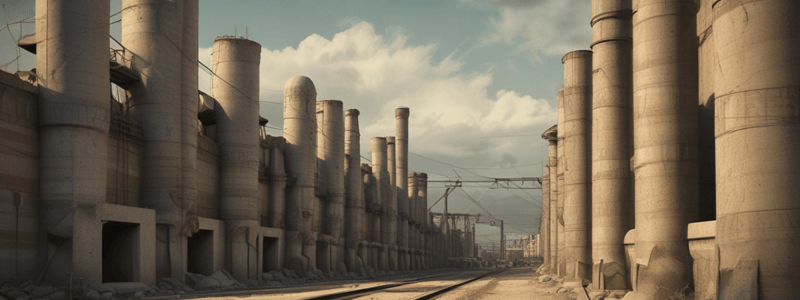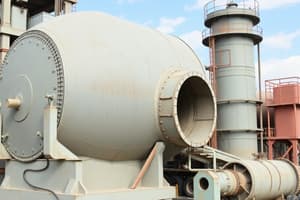Podcast
Questions and Answers
What was the initial use of cement?
What was the initial use of cement?
- Making concrete
- Making mortar (correct)
- Road construction
- Building construction
What led to the requirement for consistently higher standard material?
What led to the requirement for consistently higher standard material?
- Use of cement for making mortar
- Advancements in cement manufacturing
- Use of cement for making concrete (correct)
- Increase in construction projects
In what year was the British standard specification for Portland cement first drawn up?
In what year was the British standard specification for Portland cement first drawn up?
- 1904 (correct)
- 1877
- 1910
- 1920
What are the two main types of materials required for the manufacture of Portland cement?
What are the two main types of materials required for the manufacture of Portland cement?
What is the temperature range at which the material sinters and partially fuses to form clinker?
What is the temperature range at which the material sinters and partially fuses to form clinker?
What is added to the clinker to form Portland cement?
What is added to the clinker to form Portland cement?
What are the two processes of cement manufacture?
What are the two processes of cement manufacture?
What is fed into the rotary kiln?
What is fed into the rotary kiln?
What happens to the water in the mixture as it moves down the kiln?
What happens to the water in the mixture as it moves down the kiln?
What is the primary factor that influences the properties of cement?
What is the primary factor that influences the properties of cement?
What is the term used to describe the calculation of the potential composition of Portland cement?
What is the term used to describe the calculation of the potential composition of Portland cement?
Which of the following oxides is NOT a major compound in Portland cement?
Which of the following oxides is NOT a major compound in Portland cement?
What is the formula for calculating the percentage of C3S in cement?
What is the formula for calculating the percentage of C3S in cement?
What is the purpose of R.H.Bogue's work in the context of cement?
What is the purpose of R.H.Bogue's work in the context of cement?
What are the oxides of sodium and potassium known as?
What are the oxides of sodium and potassium known as?
What is the term used to describe the four major compounds in Portland cement?
What is the term used to describe the four major compounds in Portland cement?
What is the purpose of the table showing the approximate oxide composition limits of ordinary Portland cement?
What is the purpose of the table showing the approximate oxide composition limits of ordinary Portland cement?
What is the name of the process that occurs in the kiln at high temperature?
What is the name of the process that occurs in the kiln at high temperature?
What is the purpose of reducing C3S and C3A in low-heat cement?
What is the purpose of reducing C3S and C3A in low-heat cement?
What is the characteristic of modified cement (Type II)?
What is the characteristic of modified cement (Type II)?
What is the effect of sulfates on ordinary Portland cement?
What is the effect of sulfates on ordinary Portland cement?
What is the approximate volume increase of calcium sulphoaluminate?
What is the approximate volume increase of calcium sulphoaluminate?
What accelerates sulfate attack in ordinary Portland cement?
What accelerates sulfate attack in ordinary Portland cement?
What is the main characteristic of sulfate-resisting cement (Type V)?
What is the main characteristic of sulfate-resisting cement (Type V)?
What is the limit of C3A content in sulfate-resisting cement according to ASTM C 150-09?
What is the limit of C3A content in sulfate-resisting cement according to ASTM C 150-09?
What is the restriction on the sum of C4AF plus twice the C3A content in sulfate-resisting cement?
What is the restriction on the sum of C4AF plus twice the C3A content in sulfate-resisting cement?
What is the limit of magnesia content in sulfate-resisting cement?
What is the limit of magnesia content in sulfate-resisting cement?
What is a pozzolanic material?
What is a pozzolanic material?
What is fly ash?
What is fly ash?
What is an advantage of Portland Pozzolana Cement (PPC)?
What is an advantage of Portland Pozzolana Cement (PPC)?
What is the purpose of electrostatic precipitator in thermal power stations?
What is the purpose of electrostatic precipitator in thermal power stations?
What is the effect of pozzolanic action on soluble calcium hydroxide?
What is the effect of pozzolanic action on soluble calcium hydroxide?
What is the effect of PPC on permeability?
What is the effect of PPC on permeability?
How does PPC compare to OPC in terms of heat of hydration?
How does PPC compare to OPC in terms of heat of hydration?
What is a characteristic of Portland Pozzolana Cement?
What is a characteristic of Portland Pozzolana Cement?
What is a condition for achieving higher long-term strength in PPC?
What is a condition for achieving higher long-term strength in PPC?
What is the primary role of tricalcium silicate (C3S) and dicalcium silicate (C2S) in cement?
What is the primary role of tricalcium silicate (C3S) and dicalcium silicate (C2S) in cement?
What is the effect of C3A in cement?
What is the effect of C3A in cement?
What is the purpose of C4AF in cement?
What is the purpose of C4AF in cement?
What happens when anhydrous cement is mixed with water?
What happens when anhydrous cement is mixed with water?
What is the term for the chemical reactions between cement and water?
What is the term for the chemical reactions between cement and water?
What is the nature of the reaction between cement and water?
What is the nature of the reaction between cement and water?
What is the term for the heat liberated during the reaction of cement with water?
What is the term for the heat liberated during the reaction of cement with water?
How does the rate of hydration of pure compounds vary?
How does the rate of hydration of pure compounds vary?
What is the significance of the hydration products formed during the reaction of cement and water?
What is the significance of the hydration products formed during the reaction of cement and water?
Flashcards are hidden until you start studying
Study Notes
Early Period of Cement
- In the early period, cement was used for making mortar only.
- Later, the use of cement was extended for making concrete.
Development of Standards
- Association of Engineers, Consumers, and Cement Manufacturers was established to specify standards for cement.
- German standard specification for Portland cement was drawn in 1877.
- British standard specification was first drawn up in 1904.
- The first ASTM specification was issued in 1904.
Manufacture of Portland Cement
- Raw materials required for manufacture of Portland cement are calcareous materials (limestone or chalk) and argillaceous material (shale or clay).
- Cement factories are established where these raw materials are available in plenty.
- The process of manufacture of cement consists of:
- Grinding the raw materials
- Mixing them intimately in certain proportions
- Burning them in a kiln at a temperature of about 1300 to 1500°C
- Cooling and grinding the clinker to fine powder with addition of about 3 to 5% of gypsum
Composition of Portland Cement
- The four compounds usually regarded as major compounds are:
- Tricalcium silicate (C3S)
- Dicalcium silicate (C2S)
- Tricalcium aluminate (C3A)
- Tetracalcium aluminoferrite (C4AF)
- The calculation of the potential composition of Portland cement is based on the work of R.H. Bogue and others, and is often referred to as "Bogue composition".
Hydration of Cement
- Anhydrous cement does not bind fine and coarse aggregate.
- The chemical reactions that take place between cement and water is referred to as hydration of cement.
- The quality, quantity, continuity, stability, and the rate of formation of the hydration products are important.
Heat of Hydration
- The reaction of cement with water is exothermic, liberating a considerable quantity of heat.
- Different compounds hydrate at different rates and liberate different quantities of heat.
- Low-heat evolution is achieved by reducing the contents of C3S and C3A which are the compounds evolving the maximum heat of hydration and increasing C2S.
Types of Cement
- Modified cement (Type II):
- Combines a somewhat higher rate of heat development with a rate of gain of strength similar to that of ordinary Portland cement.
- Recommended for use in structures where a moderately low heat generation is desirable or where moderate sulfate attack may occur.
- Sulfate-resisting cement (Type V):
- Has low C3A and comparatively low C4AF content.
- ASTM C 150-09 specification limits the C3A content to 5 per cent, and also restricts the sum of the content of C4AF plus twice the C3A content to 25 per cent.
- Portland Pozzolana cement (PPC):
- Has advantages such as:
- Economical due to replacement of costly clinker with cheaper pozzolanic material.
- Improved permeability due to conversion of soluble calcium hydroxide into insoluble cementitious products.
- Reduced heat of hydration.
- Improved pore size distribution and reduced microcracks at the transition zone.
- Higher long-term strength beyond a couple of months if enough moisture is available for continued pozzolanic action.
- Has advantages such as:
Studying That Suits You
Use AI to generate personalized quizzes and flashcards to suit your learning preferences.




